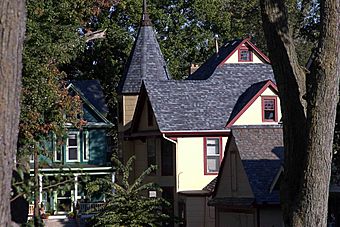Lakeside Historic District (Fort Wayne, Indiana) facts for kids
Quick facts for kids |
|
|
Lakeside Historic District
|
|
 |
|
| Lua error in Module:Location_map at line 420: attempt to index field 'wikibase' (a nil value). | |
| Location | Between Tennessee Avenue, Saint Joe Boulevard, Edgewater, and Crescent and California Avenues Fort Wayne, Indiana |
|---|---|
| Built | 1890-1940 |
| Architectural style | Queen Anne, American Craftsman, Colonial Revival, Cape Cod, American Foursquare |
| NRHP reference No. | 100001879 |
| Added to NRHP | 2018 |
The Lakeside Historic District is a special neighborhood in Fort Wayne, Indiana. It's recognized as a historic district on the National Register of Historic Places. This means its buildings and history are important to the country. The district was added to this list in 2018.
Contents
Exploring the Lakeside Historic District
The Lakeside Historic District is located in Fort Wayne, Indiana. It's bordered by Tennessee Avenue to the north and Saint Joe Boulevard to the west. The Saint Joseph River flows along its western edge. To the south, you'll find Edgewater Avenue, which follows the Maumee River. Crescent and California Avenues form the eastern boundary.
This district has a mix of straight and curved streets. It's home to over 470 buildings. Most of these were built between 1890 and 1940. You can see many different house styles here, such as:
- Queen Anne
- American Craftsman
- Colonial Revival
- Cape Cod
- American Foursquare
- American Small House
How the Neighborhood Was Planned
The way Lakeside Historic District is laid out was shaped by the land itself. It was also influenced by ideas from a city planner named Charles Mulford Robinson. Even though the area was already being developed, Robinson was hired to study the city's growth.
The developer, David N. Foster, used some of Robinson's ideas. For example, he made sure houses were set back the same distance from the street. He also encouraged open lawns without fences and trees planted near the curbs. Foster called his development "Lakeside Park Addition."
Originally, Foster planned a small park near Tennessee and Oneida Avenues. But later, a much larger park, called Lakeside Park, was created a bit further east. The first planned park area was then used for houses. Lakeside Park was part of the original plan for the area. However, it is now just outside the historic district's current borders.
Early Days and Growth
Building in the Lakeside District began in 1890. To encourage people to buy land, the developer offered to pay the first year's property taxes. They also offered to help finance house construction if buyers paid cash for the land. Advertisements for this plan ran in the Fort Wayne Journal newspaper.
The developer also used the ponds being dug for the nearby Lakeside Park as a selling point. They promised to build dikes for flood protection once the park was finished. Dirt from digging the ponds was used to build these dikes.
To help new residents get around, the Lakeside Street Railroad Company was formed. This company ran streetcars to take people from the new neighborhood to downtown Fort Wayne. The streetcar line eventually became part of larger transportation companies.
Facing the Great Flood of 1913
The growing Lakeside Park Addition faced a big challenge during the 1913 Fort Wayne Flood. On March 25, 1913, the community was alerted to rising waters. Volunteers watched the Coombs Street Bridge.
People worked together to reinforce the dike along Edgewater Avenue. However, the dike along Saint Joe Boulevard broke. Water rushed into the district through Lake and Columbia Avenues. Workers quickly threw bags of concrete into the break to try and stop the water.
By the end of March, the water began to go down. The community then started the big job of cleaning up. Everyone worked hard to help each other recover from the flood.

